- Super Glue vs Epoxy - February 10, 2022
- How to Get Started with Stippling Art - January 18, 2022
- Brother PE770 Review and Guide - January 14, 2022
With Christmas just around the corner, there’s only so much time left to find the perfect gifts for your loved ones and get the whole house dressed up in festive gear.
For the craft-savvy amongst us, that only means one thing…
…Getting out your serger and sewing machine to start sewing gifts for loved ones and decorations for your beautiful home.
It’s also time to treat yourself or perhaps another craft-lover to some new serger thread so that you can complete these new projects in style. Whether you’re buying for yourself or someone else, the best serger thread can make all the difference to the durability and look of your next crafting endeavor.
In light of that, in this article, we’ll walk you through everything you need to know about serger threads, what to look out for, and how to choose the best type for your next project.
There’s lots to discuss, so grab a cup of coffee, and let’s dive straight in!
What’s Serger Thread?
If you’re new to serging, you might not be familiar with the components you need to do it well.
For one, you might be wondering if you can’t just use any old thread with your serger?
In short, no, you can’t.
For the uninitiated, serging (sometimes referred to as overlocking) is the process of using a serging machine to seam and stitch the edges of your fabric for a more professional finish.
With a serger, you can:
- Sew seams
- Overcast edges
- Make flatlock seams
- Create rolled hems
- Easily handle stretchy fabric
- Gather fabric
Unlike a sewing machine, sergers can’t perform sewing functions like making buttonholes, sewing on buttons, or using other special attachments.
But, on the other hand, sergers can sew difficult fabrics, including Lycra and stretch knits.
Serging Thread vs. Sewing Thread
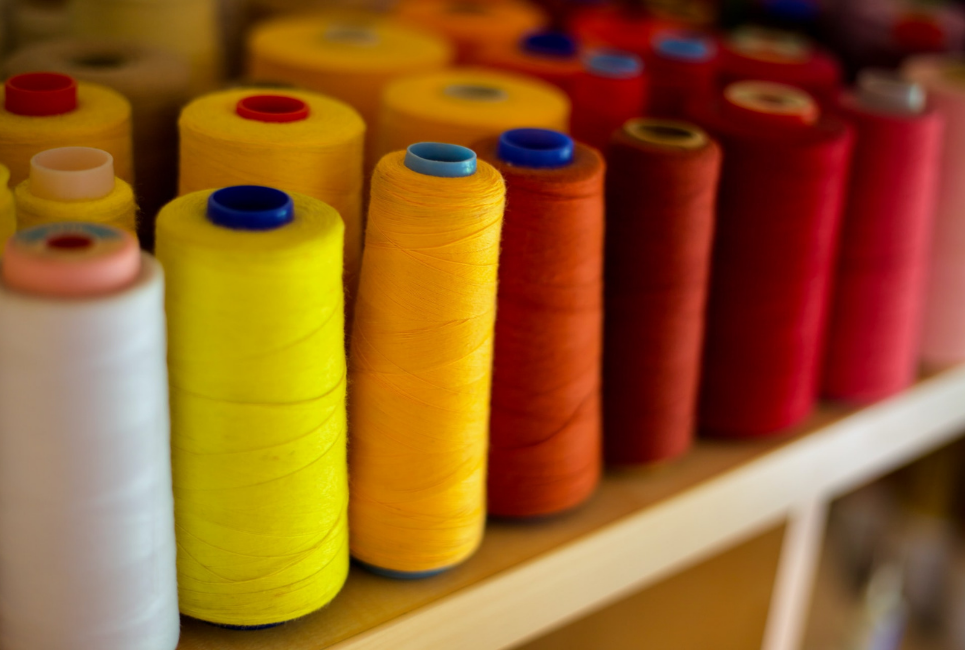
While these machines have become more versatile, you can certainly get creative, serger threads are imperative for ensuring your projects run smoothly. This is because sergers have an overlocker system which requires a thinner, smoother type of sewing thread compared to that used by a classic sewing machine.
In addition, the thread travels through the machine at a much higher speed than a regular sewing machine, making a smoother thread a better choice.
It’s also worth noting that regular thread is bought in smaller amounts and at higher prices – namely because it’s used for smaller projects. Also, it often has a fuzzier texture than serger thread.
In contrast, the serging process uses lots of thread to construct a seam and finish a fabric’s raw edges. As a result, serger thread spools often hold anywhere between 2,000 and 3,000 yards of thread!
What To Look For in a Serger Thread
Now you know the basics, let’s look at a few qualities worth considering during your hunt for the best serger thread. Of course, not all serger threads are the same, and a high-quality thread can prevent issues like fraying, excess lint, breaking, or skipped stitches. So be sure to bear these factors in mind:
Thread Fibrosity
The thread fiber’s character depends on the thread’s construction, i.e., the tightness of the twists, the type of material used (natural or synthetic), and the chemicals used to secure the threads (plastic or wax, etc.).
For serging, this is important because when the thread is passed through the fabric, looser fiber threads get stuck in the material and weaken the overall locking mechanism. Loose thread can also be detrimental to the machine itself, as threads with looser fibers can damage the tension disks inside the machine.
The Best Serger Thread Is Smooth and Even
Smooth and even thread typically goes hand in hand with strength and durability, which you need for seaming and hemming your projects. As polyester tends to be smooth and even, threads made from this material tend to be the highest-quality serger threads.
Avoid hairy-looking thread, as this won’t run through your machine as smoothly and will leave plenty of lint for you to clean up. You should also avoid threads that don’t come with uniform thickness, as this may cause tension issues in your finished project and cause threads to break.
You can test the serger thread for yourself by taking a small section between your hands and examining it for short fibers. Of course, the more fibers you can see, the worse the thread is, and the more lint that will clog up your machine as you serge.
Thread Weight
Seger thread weight is determined by the length of one gram of thread. In other words, the higher the weight number, the thinner the thread. Most serger thread has a weight of 40, but you can also purchase 50 or other weights.
Threads with a lower weight will stand out more as they’re often looser and “thicker.” As such, they’re best used for quilting stitches. Instead, 40 is ideal for most embroidery thread projects, whereas 50 and over is best for finely detailed projects and intricate work.
Price
Aside from the basic qualities above, you’ll also want to consider the price of the thread. Here, there are a few things to consider:
- The amount of thread you need for your project: You’ll require up to four different spools for overlocking. This means more thread has to be purchased for your projects, which, of course, means more expense. Though, you can somewhat remedy this by selecting colors that can be used for more than one project.
- Loose fiber thread: Lower-quality, cheaper threads tend to have looser fibers, so balancing thread cost with quality is essential.
Color
The color of your serger thread will depend entirely on the project you’re undertaking. White, black, and neutral colors are helpful because they complement most projects.
But, generally, you’ll find that colors affect the following types of stitches:
- Four and three-thread overlock: This is used to join layers of fabric (seam) and prevent fraying. You’ll need four different spools to achieve this finish. However, only the thread running through the outer needle can be seen when you use this stitch. The other three thread colors can be chosen randomly depending on what colors you have.
- Blind hem: This is when you attempt to make your thread invisible. However, since this is very difficult to achieve, it’s worth selecting serger threads that match the colors of the materials you’re using.
Different Types of Serger Thread
There are different types of serger threads available. Unsurprisingly, the best one for you will depend entirely on the project you’re looking to execute. So here we’re going to introduce seven basic serger thread types and what they’re best suited for:
Serger Cone Thread
Serger cone thread is the standard serger thread intended for general serging. However, it can be used for virtually all serger machine projects, including finishing edges and serging seams with the looper threads and the needle.
The looper threads are what make sergers different from regular sewing. There are loops or small levers with thread holes inside the machine that act like knitting needles.
A looper thread will travel between two or more needles into the back of the fabric and then go over the top of the other thread layers (also known as overcasting). Rather than penetrating the fabric, the loops go around the raw edge of the fabric to lock in stray edges and seams.
Serger cone thread is plain white and comes in spools of over 5,000 yards. In short, it’s convenient, lasts a long time, and is budget-friendly. This thread usually consists of core-spun polyester, which is cross-wound onto a cone-shaped spool, hence its name.
When you use a serger machine, you’ll see a line of extendable or pre-extended thread trees where the cone thread spool will sit. Usually, there’s space for 3-5 spools of cone thread. The thread is then guided through the serger machine to construct the overlocking stitches.
Cone threads are designed explicitly for sergers because the thread unwinds from the top and doesn’t spin the cone, allowing for smoother feeding through the serger when the machine runs at high speeds.
As we’ve discussed above, high-quality serger thread is uniform, smooth, and strong to withstand the fast serging process. You can choose between polyester and cotton serger thread.
Although cotton thread tends to be softer and stronger, it’s more likely to shrink and produce more lint. That’s why for many hobbyists and professionals alike, polyester serger cone thread is the preference.
Some of the most popular serger cone threads include:
Ilauke’s White Polyester Cone Thread

- 4.8/5 stars on Amazon
- 4 cones – each with 3000 yards length
New brothread All-Purpose Polyester Sewing Cone Thread for Overlocking

- Rating on Amazon is 4.7/5 stars
- Comes with two cones – each 5,000 yards
Gutermann Miniking Universal Sewing Thread Overlocking Thread Cones
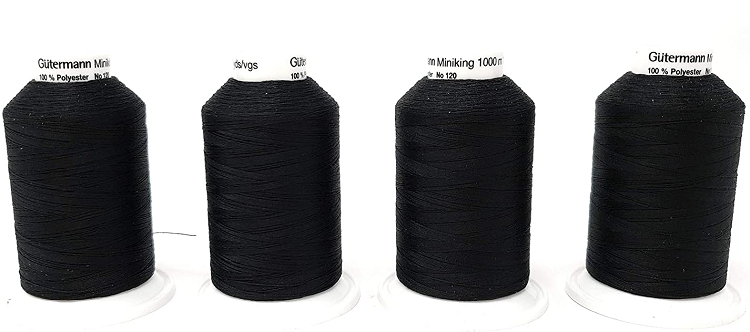
- 4.8/5 stars (Amazon)
- 4 cones – each 1000 yards
General Purpose Thread
Know the rules so you can break them…
You can, in fact, use general sewing machine thread on a serger. But just because you can doesn’t mean you should – at least not for all applications. For example, you should consider other options for your loopers (most sergers have an upper and lower looper that you’ll see when you thread your needles).
All-purpose threads are wound parallel on spools and are available in craft stores or even local Walmarts. They’re typically made for traditional sewing machines and are used for finishing fabric edges, decorative construction, and seams.
However, they can also be used with a serger machine to create a slightly thicker-looking finish. For this reason, be cautious as you proceed with regular thread as it’s double the thickness (3-4ply), as opposed to serger thread (2ply).
You may also want to use spool caps over the regular thread as the thickness can cause it to unwind, and the caps will keep the thread on the spool as you sew.
General-purpose thread fibers are typically composed out of cotton and polyester, or even polyester covered in cotton. It’s an attractive option because it’s available in all colors. It’s also strong and durable. However, compared to serger thread spools, one downside is that the spools don’t come with as much thread spun onto them, and with how much your serger goes through, you’ll constantly be replacing your thread.
In light of that, to make your general-purpose thread go further, consider using it just for the left needle when sewing seams. Then, use a serger cone thread for the right needle and loopers.
Some of the best general-purpose threads on the market include:
Gutermann Sew-All Thread
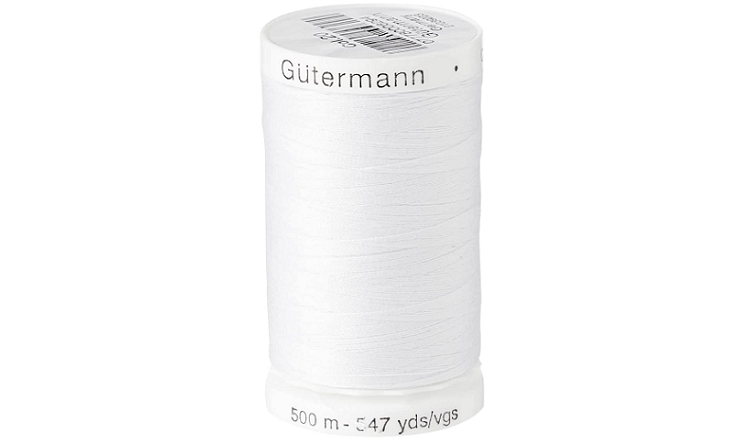
- One spool is 547 yards long
- 4.8 out of 5 stars (Amazon)
Coats & Clark All Purpose Thread

- One spool is 400 yards
- 4.7 out of 5 (Amazon)
Leonis Polyester All Purpose Sewing Threads
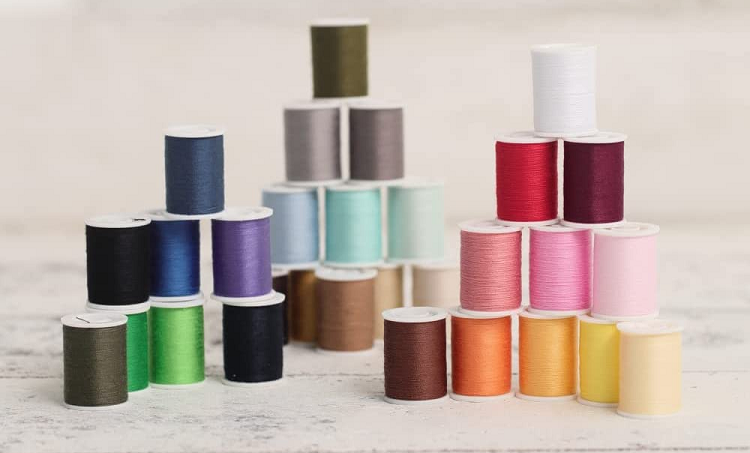
- Comes with 30 thread spools with variable lengths (between 50 and 110 yards)
- 4.4 out of 5 stars (Amazon)
Nylon Sewing Thread
Nylon is a strong thread used for sportswear, bags, upholstery, and more. But, unfortunately, it isn’t one of the top options for serger users.
Nylon has a habit of losing its color and melting at high temperatures. So, when you iron this thread, you’ll need to turn the temperature down and use a press cloth. If you do decide to go with nylon, we recommend:
Seldric #69 T70 Size 210D Black Nylon Thread
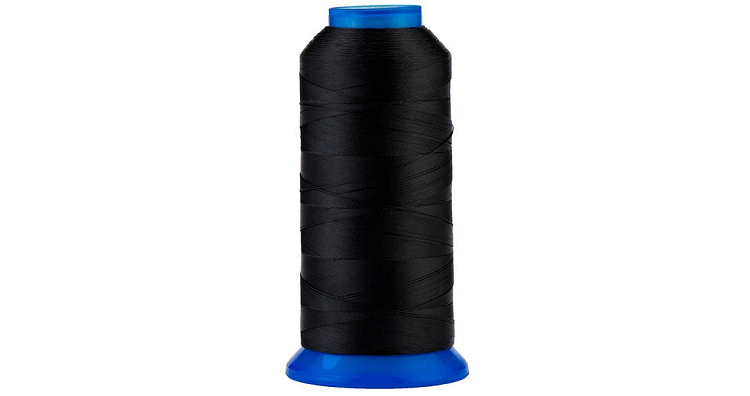
- One spool is 1500 yards
- 4.5/5 stars (Amazon)
Aussel Bonded Nylon Sewing Thread
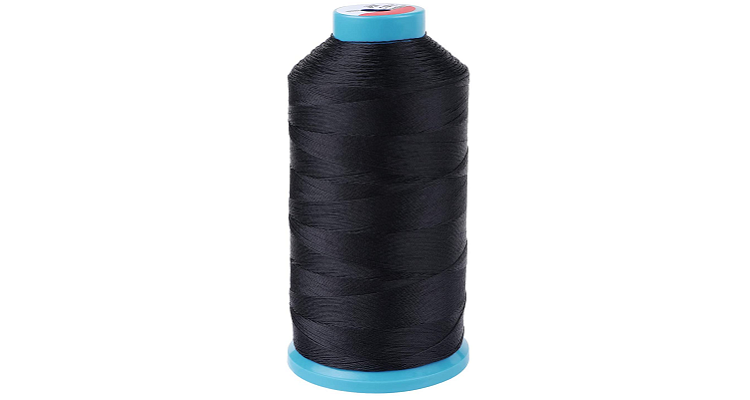
- 1,500 yards per spool
- 4.6/5 stars (Amazon)
WheateFull Tight Strong Black Bonded Nylon Sewing Thread
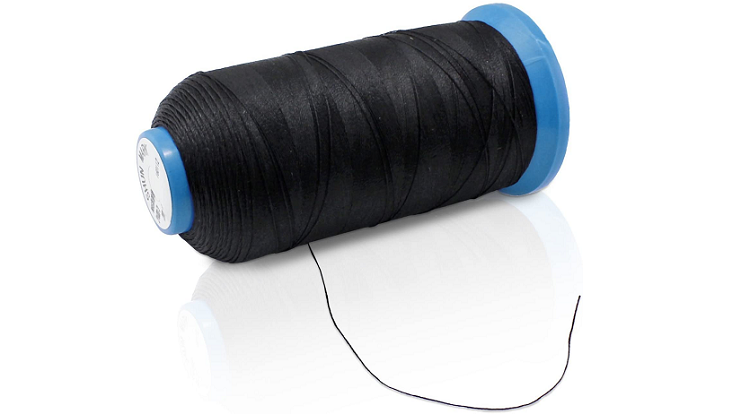
- One spool is approx 1585 yards
- 4.6/5 stars (Amazon)
Polyester or Rayon Embroidery Machine Threads
Embroidery machine threads are usually either made out of rayon or polyester. They’re well known for their beautiful luster and shine and come in a wide range of colors, making them perfect for embroidery.
The best time to use embroidery machine threads in your needles is when you can’t find a matching serger thread color for stitching seams. In that case, you can use them to create beautiful decorative effects, like rolled edges and flat locking.
Out of rayon and polyester, polyester threads tend to be stronger and keep their color better, making them more suitable for seams that will endure heavy wear. Some great embroidery threads include:
AUERVO Embroidery Thread
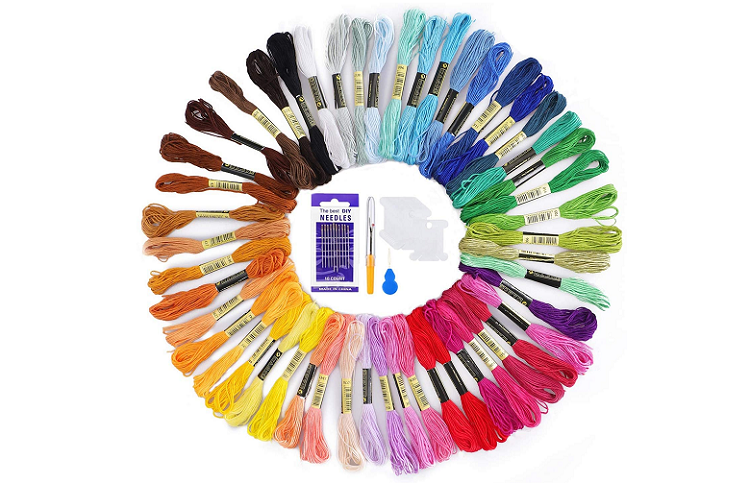
- Each floss is 8.75 yards long.
- Rating is 4.7/5 (Amazon)
New brothread Embroidery Thread
- Each floss is 55 yards long.
- 4.8/5 stars (Amazon)
elloLife Embroidery Thread

- Each floss is 8.75 yards long
- 4.8/5 stars (Amazon)
Textured Nylon Thread
As we’ve already mentioned, the smoothness of your thread is integral. However, as its name suggests, textured nylon thread is a fluffy thread available in several colors. Unfortunately, it’s soft and hairy, which might mean you’ll need a looper threader to get it where it needs to be in your machine.
Textured nylon thread benefits from good stretch and recovery and is very soft. It spreads well over cover seams when you want a rolled hem or decorative ruffle finish. It also creates softness where comfort matters, like athletic wear, swimsuits, lingerie, etc.
While, technically, you could use this type of thread on all the sergers, we’d recommend only using it for the loopers.
Textured nylon threads aren’t as easy to find, but Amazon has a few:
A&E Maxi Lock Textured Nylon Threads

- 200 yards per spool
- 5/5 stars (Amazon) but very few ratings (2)
PsmGoods Nylon Thread

- One spool is approx 1695 yards long
- 4.4/5 stars (Amazon)
NOLOGO HHTC High Elastic Nylon Woolly Thread
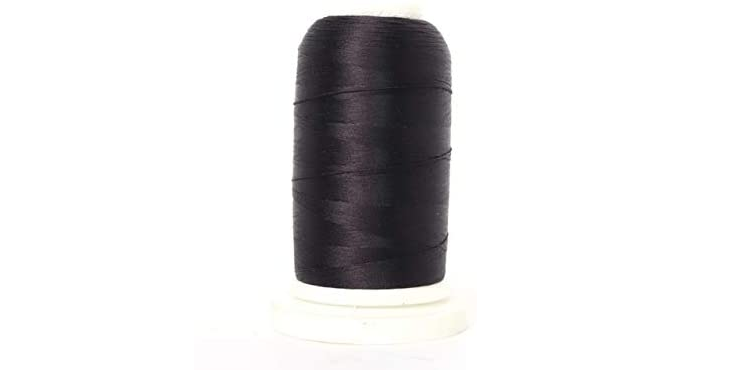
- One spool is approx 1093 yards long
- No rating as of yet
Invisible Nylon Thread (Monofilament)
Monofilament thread is a fine, strong, and transparent thread available in clear or smoke color, making it an excellent choice for creating “invisible” stitches.
However, this “invisibility” comes at a cost, as it tangles and breaks easily. In short, there’s a learning curve involved with this thread!
Some of the best invisible nylon threads are:
The SINGER 00260 Clear Invisible Nylon Thread

- One spool is 135 yards
- 4.5/5 stars (Amazon)
Habercraft Clear Nylon Thread
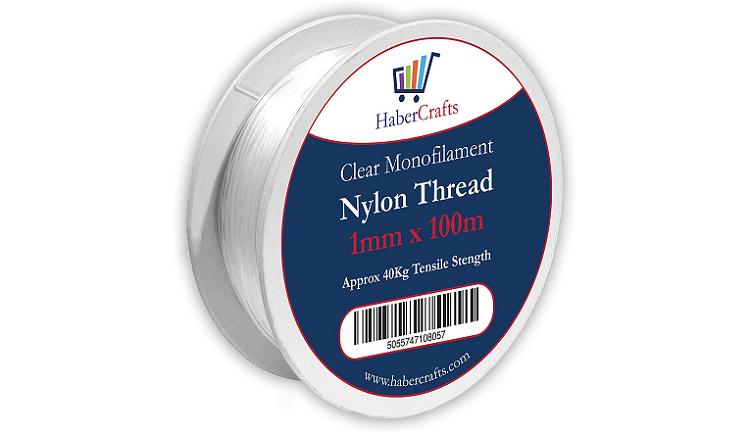
- One spool is 109 yards
- 4.4/5 rating (Amazon)
Tatuo Clear Nylon Thread
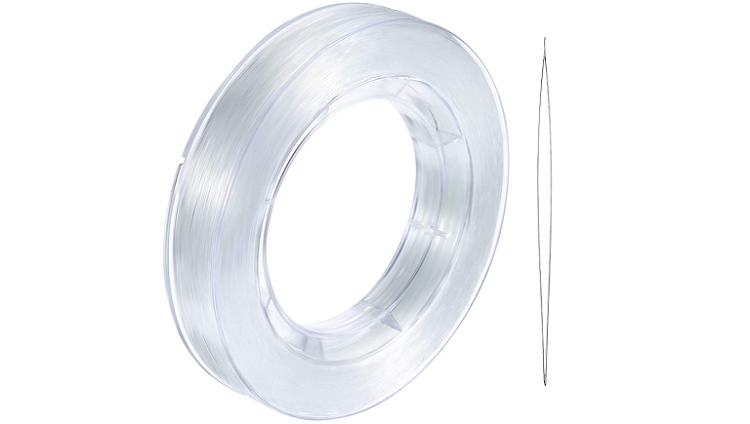
- One spool is 218 yards long
- 4.5/5 rating (Amazon)
Silk Thread
Suppose you want a particularly luxurious finish. In that case, a silk serger thread might be the right option for you. Silk thread is costly but boasts a lovely feel and shine that backs up its price. In light of its expense, we suggest only using silk thread when it will actually show.
However, if you want to save a little money, it’s worth noting that polyester and rayon threads are less expensive and still have a beautiful luster.
There aren’t many silk thread providers on Amazon, so you’ll have to do a bit of research. However, we managed to find a few that look promising:
The silk mill 100% Pure Chinese Monofilament Silk Thread
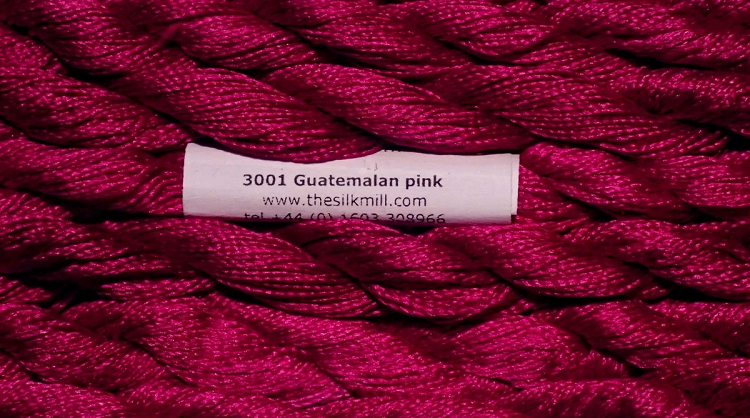
- Seven yards long
- No rating available for this product
Mettler Silk-Finish Cotton Thread Set
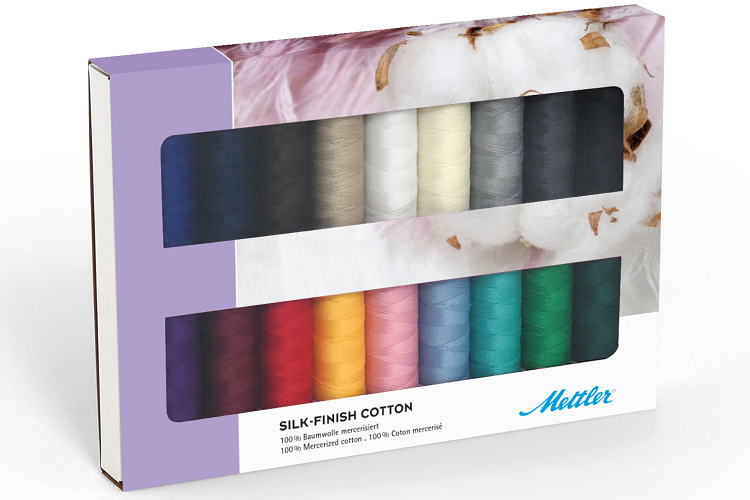
- Approx 164 yards per spool
- No rating available for this product
Decorative Serger Thread
So far, we’ve discussed serger threads for general applications like serging seams and completing edges. However, you can also use your serger (alongside the right thread) to accomplish beautiful decorative effects.
That said, here are some serger thread types that suit this purpose:
Metallic Thread
A metallic thread consists of a nylon or polyester core with metallic foil twisted around it. This gives the thread a metallic sheen, making it the perfect option if you’re looking to produce a shiny, decorative finish.
Metallic thread works exceptionally well for edge stitching and flat locking. However, keep in mind that metallic thread only has minimal stretch.
The best metallic thread we could find was:
Korbond Metallic Gold Thread

- 174 yards per spool
- 4.6/5 rating (Amazon)
Hand Embroidery Floss
The floss you use for hand embroidery might be the last thread you’d consider for serging. But with a bit of workaround, you can use these much thicker threads in your serger to create a beautiful rolled hem, decorative edges, or flat-locked stitches.
Top Tip: pick a smooth floss – not one that’s too wide or textured. Then simply wind it around a bobbin and thread it through your machine. Also, be sure to keep the speed slow when you stitch!
A Good Example Is, Pllieay Black Embroidery Thread
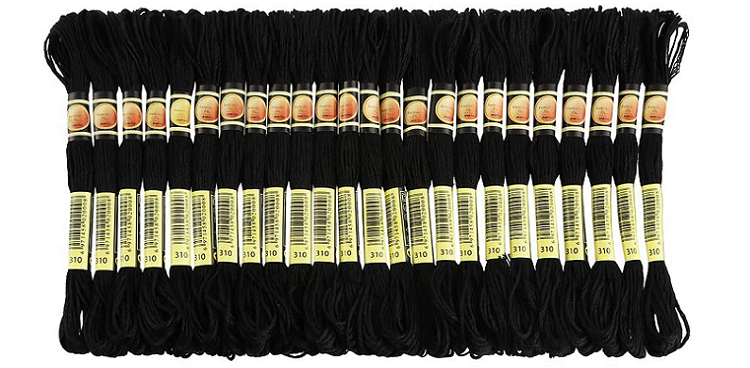
- Each floss is 8.75 yards long
- 4.7/5 rating (Amazon)
Serger Yarn
Serger yarn is a bulky yarn that’s great for decorative edging. It’s commonly used for fleece blankets and sweaters. Typically, this yarn comes cross-wound specifically for serging and can only be threaded into the loopers.
One Example Is: Milisten Sewing Threads Yarn Spools Cone for Serger
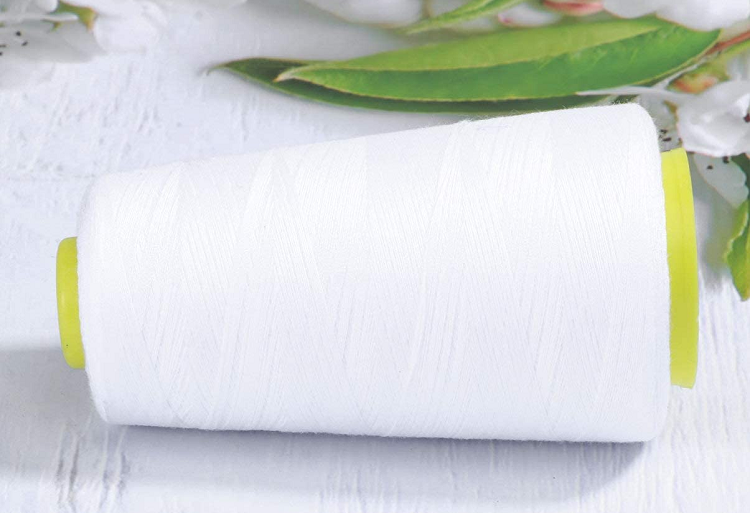
- 3,000 Yards per spool
- 4.2/5 rating (Amazon)
Serger Ribbon
You can even get ribbons made specifically for serging! Of course, you’ll need to be careful when feeding these ribbons through your serger. But once you get the hang of these slightly difficult-to-handle, broader threads, you can use them for fun decorative finishes on a wide variety of projects.
You have two options for serging ribbon. You can either buy a ribbon that already has a serged end (called wire-end ribbon) or serge the ribbon yourself.
In the latter case, we recommend:
RUSPEPA Satin Ribbon
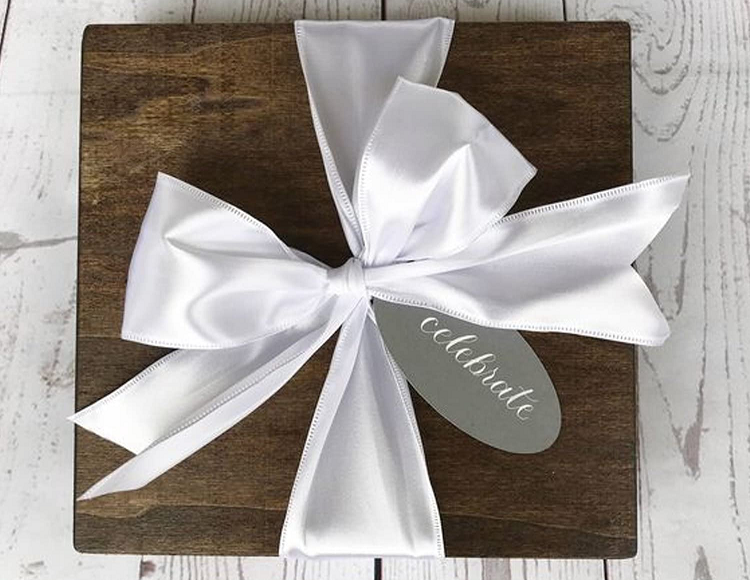
- 9.8 yards per reel
- 4.7/5 rating (Amazon)
What Serger Thread Will You Need To Start With?
For plenty of beginner projects, you can get away with buying some serger thread basics. For instance, if you have a regular four-thread overlock, you could begin your serger thread collection by starting off with:
- Enough whites: Four large serger thread cones, at 3,000 yeards each, is a good start.
- Dark colors and black threads: Stock up on at least four spools of darker colors – navy, black, dark grey, etc.
- Neutrals: Neutral colors complement a wide range of color palettes – for instance, beige, cream, grey, tan, etc.
Where To Buy the Best Serger Thread
Your local craft or sewing shop will often have a great variety of serger threads available. But you can just as quickly order your serger thread on online marketplaces like Amazon. Even stores like Walmart tend to sell standard 300-yard cones. You can also browse threads from some of the most popular serger thread brands online, including Maxi-Lock and Gutermann.
FAQs
Last but not least, let’s round off this blog post by answering some of the most commonly asked questions we hear about serger threads:
Question: How Many Spools of Thread Will I Need for a Serger?
Answer: Most sergers come with a common four-thread overlocker, which means you’ll need to purchase four spools. However, you don’t need to use the same thread for all of them. Instead, choose the bigger and cheaper spools for the loopers. You only need to buy decorative thread spools for the visible stitching.
Question: Does Serger Thread Need to Match my Fabric?
Answer: Only the thread on the outside needle position will be visible when the serging’s completed. So, only that thread has to match the fabric or be the color you want to pair with your fabric.
Question: How Does Serger Thread React to a Wash?
Answer: Always check the label to determine whether a thread is machine washable, dryable, or pressed. Different fabrics may react differently to hot water.
For example, cotton risks shrinking in the wash, whereas nylon can melt under high temperatures making it unsuitable for ironing. However, most basic serger threads can be machine washed without any worries.
Question: Can I Use Serger Thread in a Regular Sewing Machine?
Answer: Regular serger thread cones are too large for the average sewing machine. So while they’re economical, you can only use them with a workaround like a thread stand.
Many sewing enthusiasts also consider serger thread weaker than regular thread. As such, they tend to avoid it for their typical sewing projects.
Remember – when you serge, several threads overlap, creating a sturdy seam or edge. But, individually, the thread isn’t as strong.
Question: Do Serger Threads Expire?
You might be wondering how your serger thread will withstand the years, especially in finished projects that might see a lot of use.
The shelf-life of most serger and sewing threads is 50 years. Old thread is more prone to breakage and might start to fray. A thread is also prone to color loss due to temperature, humidity, and sun exposure with age.
Find the Best Serger Thread for Your Christmas Projects
High-quality serger thread is well worth the investment if you want to ensure your seams don’t tear, shrink, or fray. However, the best serger thread type for you will depend on your application.
In light of that, we recommend stocking up on basic serger thread cones with high yardages for completing seams and edges. Then, to create fun and lustrous finishes, buy decorative serger threads like colorful silk or polyester threads, or even metallic thread.
You can easily find the best serger thread online or in local stores when you know what you’re looking for. Good luck in your search, and don’t forget to let us know which serging projects you’ll be tackling this winter in the comments below – we’d love to hear from you!
Further readings:
How to Find the Best Thread for Quilting
Needlepoint vs Cross Stitch: What are the Main Differences?


